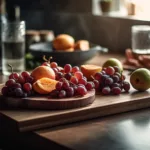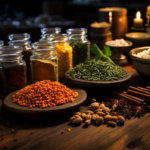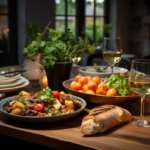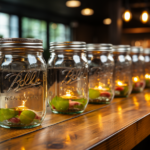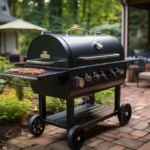Table of Contents
Discovering Wild Edibles: A Forager’s Guide to Nature’s Bounty
Have you ever considered foraging for wild edibles in nature? It’s a great way to connect with the environment and discover the bounty of food that nature has to offer. Foraging can be an enjoyable and rewarding experience, but it’s essential to be informed and know what to look for to avoid any potentially harmful plants. In this article, we’ll explore the basics of foraging for wild edibles, including what to look for, how to identify safe plants, and the best ways to prepare and enjoy them. Whether you’re an experienced forager or just starting, this guide will provide you with the knowledge and tools to safely and responsibly gather and appreciate wild edibles. Let’s dive in!
The Basics of Foraging
Foraging has been an essential part of human history for thousands of years. Before agriculture and modern transportation, people depended on wild edibles as a primary source of food. Today, foraging is making a comeback as people seek to connect with nature and explore new ways of incorporating healthy, locally sourced foods into their diets.
Foraging for wild edibles can be a fun, rewarding experience, but it’s important to do it safely. Here are some basics to keep in mind:
- Know what you’re looking for: There are many edible plants in the wild, but not all of them are safe to eat. Make sure you know what you’re looking for before you start foraging. Consult a field guide, take a class, or go with an experienced forager.
- Respect the environment: Foraging can have an impact on the environment, so it’s important to be mindful of your surroundings. Don’t take more than you need, avoid sensitive areas, and leave the area better than you found it.
- Be mindful of safety: Foraging can be dangerous if you’re not careful. Wear appropriate clothing and shoes, bring a map and compass or GPS device, and let someone know where you’re going.
- Know the laws: Foraging is regulated in some areas, so make sure you know the laws in your area before you start. Some plants are protected and may not be legally harvested.
Foraging can be a rewarding way to connect with nature and explore new foods. By following these basic guidelines, you can enjoy the benefits of foraging while minimizing the impact on the environment and staying safe.
Finding Wild Edibles
Finding wild edibles is the heart of foraging, and it can be a thrilling and fulfilling experience. The challenge of seeking out and identifying different plants and fungi in their natural habitat can be incredibly rewarding, but it can also be dangerous if you don’t know what you’re doing. Here are some tips for finding wild edibles safely and successfully:
Look in the Right Places
Different plants and fungi grow in different habitats, so it’s important to know where to look for the types of wild edibles you’re interested in. Some general guidelines include:
- Look for wild edibles in areas that are free from pollution and pesticides, such as national parks, forests, and other protected areas.
- Check the soil type and pH level of the area, as this can affect what plants and fungi grow there.
- Different plants and fungi thrive in different conditions, such as sunny or shady spots, wet or dry soil, and different elevations, so take these factors into account when searching.
Identify Your Finds
Before you start picking and eating wild edibles, it’s important to be sure that you’ve identified them correctly. Some plants and fungi can look similar to each other, and misidentification can have serious consequences. Here are some tips for identifying wild edibles:
- Use a guidebook or smartphone app to help you identify plants and fungi.
- Look for distinctive features such as leaf shape, stem color and texture, and fruiting body shape and color.
- When in doubt, don’t eat it! It’s better to be safe than sorry when it comes to wild edibles.
Harvest Ethically
When harvesting wild edibles, it’s important to do so in a sustainable and ethical way. Here are some tips to keep in mind:
- Only take what you need and leave some for others and for the wildlife that depend on these plants and fungi.
- Be mindful of the environment and avoid damaging the plants and fungi or their habitats.
- Be aware of any regulations or restrictions on harvesting wild edibles in your area.
By following these guidelines, you can safely and responsibly enjoy the bounty of nature and connect with your food in a unique and meaningful way.
Preparing and Cooking Wild Edibles
Preparing and cooking wild edibles is an essential step to ensure that they are safe to eat and enjoyable. Here are some tips on how to prepare and cook wild edibles:
Clean Your Edibles
Before you start preparing and cooking wild edibles, it is essential to clean them thoroughly to get rid of dirt, insects, and other contaminants. Rinse them with cold water and pat dry using a paper towel.
Identify the Edibles Correctly
Proper identification of wild edibles is critical before preparing and cooking them. It is essential to identify them using a field guide or expert’s assistance to ensure that they are safe to eat.
Cooking Techniques
Different cooking techniques can be used to prepare wild edibles. Some common techniques include boiling, sautéing, roasting, grilling, and baking. It is essential to choose a technique that suits the specific edible you want to cook.
Experiment with Flavors
Experimenting with flavors is a great way to enjoy wild edibles. Adding herbs, spices, and other seasonings can add an extra taste to the wild edibles. You can also mix them with other ingredients to create unique dishes.
Be Careful with Poisonous Edibles
Some wild edibles can be poisonous or toxic. It is essential to avoid them at all costs or seek expert assistance to identify them correctly. Consuming poisonous wild edibles can lead to severe health consequences.
Avoid Overcooking
Overcooking wild edibles can destroy the nutrients and natural flavors, making them unpalatable. It is essential to follow the cooking instructions carefully and avoid overcooking.
In conclusion, preparing and cooking wild edibles requires patience, knowledge, and skill. Proper identification, cleaning, and cooking techniques are critical to ensure that they are safe to eat and enjoyable. Experimenting with flavors and cooking techniques can create unique dishes and enhance the experience of foraging for wild edibles.
Conclusion
Foraging for wild edibles is a wonderful way to connect with nature and experience the joy of harvesting and cooking your own food. While foraging may seem like a daunting task for beginners, it is a skill that can be learned and practiced with the right knowledge and preparation.
In this article, we have explored the basics of foraging, including the types of wild edibles you can find, where to look for them, and how to properly prepare and cook them.
By understanding the fundamentals of foraging, you can not only enjoy the benefits of fresh and free food but also foster a deeper appreciation for the natural world around you.
It is important to remember that foraging comes with risks, and not all wild edibles are safe to consume. It is crucial to do your research, seek guidance from experts, and be cautious when identifying and harvesting wild plants.
Despite the potential dangers, foraging can be a fun and rewarding activity that connects us with our food and the natural world. It is a wonderful way to get outside, learn about local ecosystems, and discover new flavors and textures.
So, whether you are an experienced forager or just starting out, get out there and explore the abundance of wild edibles waiting to be discovered. Happy foraging!





